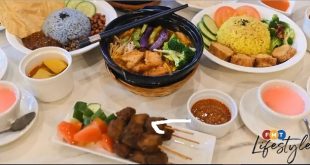There is a fascination with “kuih-muih”, these sweet and savory dishes, which truly embody the essence of Hari Raya.
If you’ve been in the Klang Valley for a while, you know that every Ramadan brings new culinary innovations, from pisang goreng cheese to dates filled with butter. But what about the traditional kuih from different states, which are rarely found in local markets? It’s time to shine a light on these fun heirlooms and maybe try your hand at keeping them alive. 1. Pudak Flower Cake
Kedah Pudak Flower Cake is named after the bright flowers of pandanus. Although the ingredients used to make it are simple, its preparation requires knowing how to do it. Therefore, few people today know how to prepare it, and some do not. First, pour the rice flour directly into the hot pan, then carefully put some shredded coconut in the middle, using a spatula, mix all the parts at once to create a base for the coconut.
A layer of sweet rice flour that covers the soft and sweet coconut inside makes this kuih unique in texture and taste. Kuih badak kubang, also known as “badak berendam”, got its name from its resemblance to rhinoceroses that wander in the mud (“badak berendam”). badak”, which literally means rhinoceros). This delicacy, once a staple of Pahang’s Chenor district, has now fallen into obscurity.
It is made from a mixture of edible rice flour and black rice flour, filled with sweet coconut that is reminiscent of onde-onde. They are placed in a banana leaf, dipped in a mixture of coconut milk – rhinos swim in the pool – before being fried.
Although its popularity has declined, you can still find kuih badak kubang at Ramadan markets in Maran, Temerloh and Jerantut.3. Thank you very much
Also known as Kuih Serunai, it is a popular dish on the East Coast. Made from rice flour, this kuih has two fillings wrapped inside a banana leaf cone.
To prepare the bottom layer, gula Melaka or nisey kerek sugar, water, pandan leaves, rice flour, tapioca flour and other ingredients are cooked until it hardens. The mixture is poured into a banana leaf and steamed for five minutes.
A white layer of rice flour, a mixture of rice flour, wheat flour and coconut milk, is placed on top of a layer of baking paper, before being baked. Don’t confuse kuih jala with roti jala: while they both share the same pattern as nets, they differ in texture and taste. Believed to have originated in Sabah, kuih jala is a traditional dish that is often seen at festive events and weddings, where it is often served as an entrance gift.
The interesting thing about kuih jala is not only its taste but also its unique preparation. It is prepared by mixing rice powder, sugar and water until it has a thick gooey consistency. The mixture is poured into cracked coconut shells. When you do a circular motion, the mixture is poured directly into the fuel to cook it.
Once the mixture becomes golden brown, it is removed from the oil and immediately rolled into a triangular shape, making it sweet, hot and fragrant .
